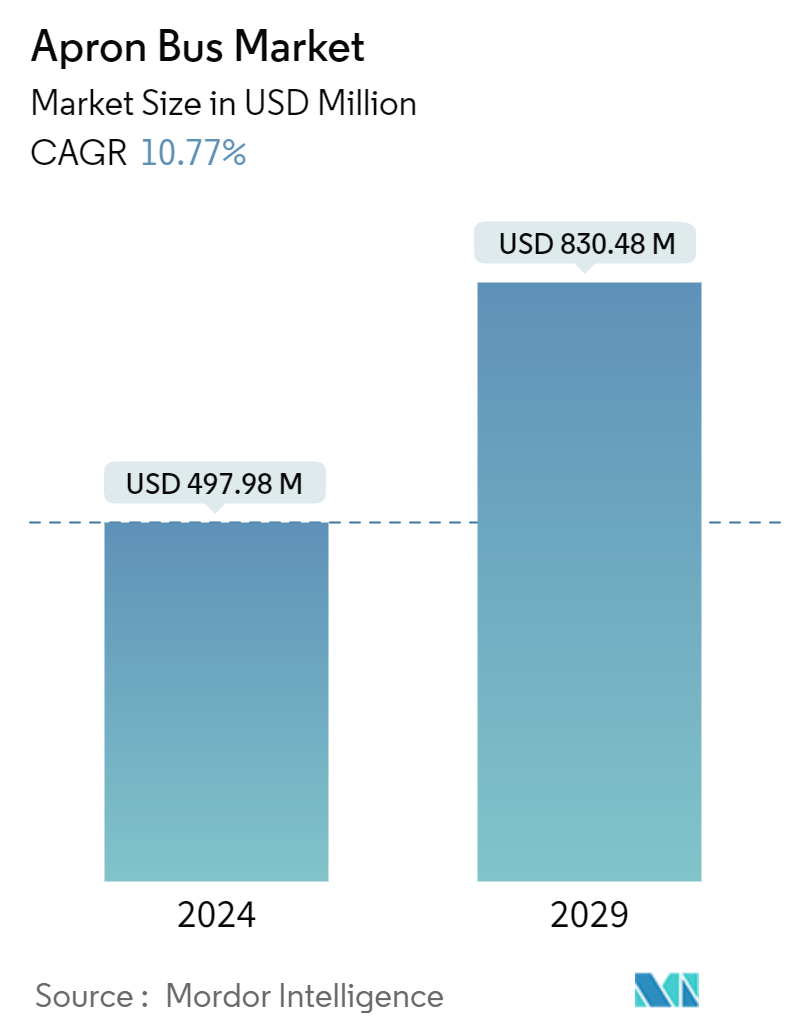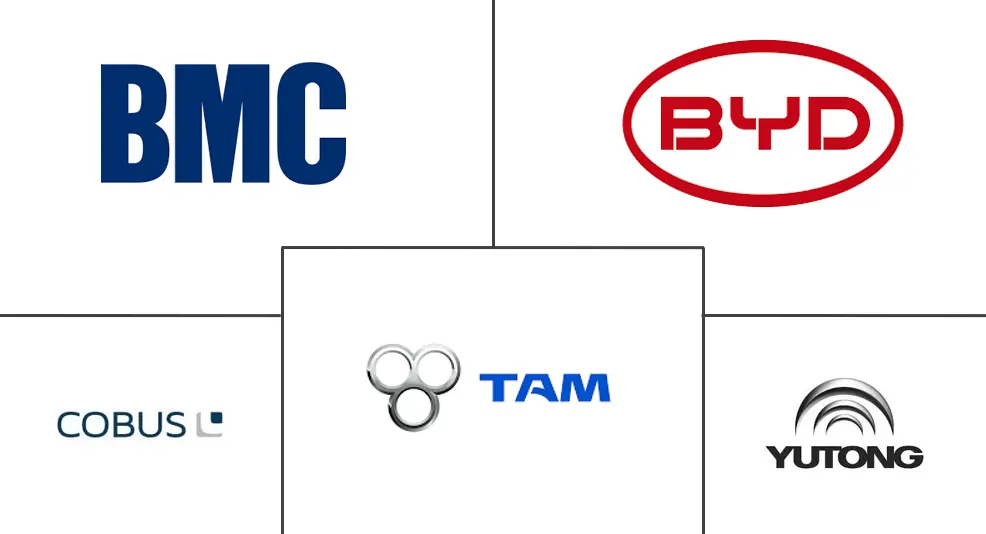Market Size of Apron Bus Industry

| Study Period | 2019 - 2029 |
| Market Size (2024) | USD 497.98 Million |
| Market Size (2029) | USD 830.48 Million |
| CAGR (2024 - 2029) | 10.77 % |
| Fastest Growing Market | Asia Pacific |
| Largest Market | Europe |
| Market Concentration | High |
Major Players
*Disclaimer: Major Players sorted in no particular order |
Apron Bus Market Analysis
The Apron Bus Market size is estimated at USD 497.98 million in 2024, and is expected to reach USD 830.48 million by 2029, growing at a CAGR of 10.77% during the forecast period (2024-2029).
Boarding significantly impacts airline costs by directly influencing aircraft turnaround time. A swift boarding process emerges as a pivotal growth driver in the apron bus market. Particularly favored at select airports, Apron buses efficiently shuttle passengers between the terminal and the aircraft.
In their pursuit of heightened passenger satisfaction, airlines are pressured to expedite boarding. The surge in air passenger traffic, coupled with expanding aircraft fleets, propels the market's growth. Furthermore, the rising demand for additional boarding bridges at airports bolsters the case for apron buses. Notably, the faster boarding process streamlines operations and enhances the overall passenger experience, garnering significant customer interest. Many airlines are transitioning to electric buses to combat emissions from aging diesel engines, often powered by Anaba's cutting-edge electronic motors.
With a notable shift toward all-electric models, bus manufacturers are poised to dominate the market. Moreover, as new airports come into play, the demand for apron buses is set to surge in the coming years.
Apron Bus Industry Segmentation
An apron bus shuttles passengers to and from airports, standing out with its unique labeling, spacious luggage compartments, and vibrant paint schemes. These features distinguish them from other airport vehicles and aid taxi crews in spotting them swiftly.
The apron bus market is segmented by type and geography. By type, the market is segmented into electric and diesel. The report also covers the market sizes and forecasts for the apron bus market in major countries across different regions. The market size is provided for each segment in terms of value (USD).
| Type | |
| Electric | |
| Diesel |
| Geography | |||||||
| |||||||
| |||||||
| |||||||
| |||||||
|
Apron Bus Market Size Summary
The apron bus market is experiencing significant growth, driven by the increasing demand for efficient passenger boarding processes at airports. As airlines strive to enhance passenger satisfaction and reduce turnaround times, apron buses have become a crucial component in airport operations. The market is further propelled by the surge in air passenger traffic and the expansion of aircraft fleets, which necessitate the use of apron buses to streamline operations. The rising demand for additional boarding bridges at airports also supports the market's expansion. A notable trend in the industry is the transition towards electric apron buses, driven by the need to reduce emissions from aging diesel engines. This shift is supported by advancements in electric motor technology, such as those developed by Anaba, and aligns with the broader industry goal of achieving carbon neutrality.
The market is characterized by a consolidation of established players, including Cobus Industries GmbH, YUTONG Bus Co. Ltd, BYD Motors Inc., BMC Otomotiv Sanayi ve Ticaret AS, and TAM - EUROPE. These companies are diversifying their product offerings to include advanced features and eco-friendly solutions, such as electric buses with spacious designs for passengers and luggage. The global push for reduced carbon emissions is prompting airports and airlines to phase out older diesel buses in favor of electric models, contributing to the market's growth. European airports, in particular, are leading the charge in adopting electric apron buses, supported by ambitious environmental targets set by the European Commission. The market is expected to continue expanding as new airports are constructed and aging buses are replaced, providing fresh opportunities for industry players.
Apron Bus Market Size - Table of Contents
-
1. MARKET DYNAMICS
-
1.1 Market Overview
-
1.2 Market Drivers
-
1.3 Market Restraints
-
1.4 Industry Attractiveness - Porter's Five Forces Analysis
-
1.4.1 Bargaining Power of Suppliers
-
1.4.2 Bargaining Power of Buyers/Consumers
-
1.4.3 Threat of New Entrants
-
1.4.4 Threat of Substitute Products
-
1.4.5 Intensity of Competitive Rivalry
-
-
-
2. MARKET SEGMENTATION
-
2.1 Type
-
2.1.1 Electric
-
2.1.2 Diesel
-
-
2.2 Geography
-
2.2.1 North America
-
2.2.1.1 United States
-
2.2.1.2 Canada
-
-
2.2.2 Europe
-
2.2.2.1 United Kingdom
-
2.2.2.2 Germany
-
2.2.2.3 France
-
2.2.2.4 Russia
-
2.2.2.5 Rest of Europe
-
-
2.2.3 Asia-Pacific
-
2.2.3.1 China
-
2.2.3.2 India
-
2.2.3.3 Japan
-
2.2.3.4 South Korea
-
2.2.3.5 Rest of Asia-Pacific
-
-
2.2.4 Latin America
-
2.2.4.1 Brazil
-
2.2.4.2 Rest of Latin America
-
-
2.2.5 Middle East and Africa
-
2.2.5.1 United Arab Emirates
-
2.2.5.2 Saudi Arabia
-
2.2.5.3 Rest of Middle East and Africa
-
-
-
Apron Bus Market Size FAQs
How big is the Apron Bus Market?
The Apron Bus Market size is expected to reach USD 497.98 million in 2024 and grow at a CAGR of 10.77% to reach USD 830.48 million by 2029.
What is the current Apron Bus Market size?
In 2024, the Apron Bus Market size is expected to reach USD 497.98 million.

